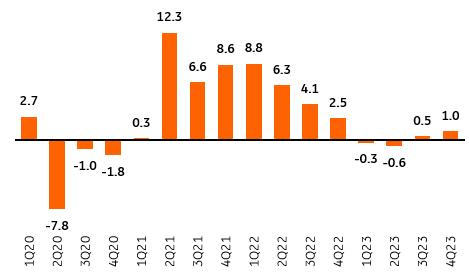Year-End Optimism For The Polish Economy Is Set To Continue In 2024

Image Source: Pexels
Poland’s GDP posted the second consecutive annual growth figure for the fourth quarter of 2023, and the second half of the year was notably better than the first. While reticent consumers and poor external demand weighed on activity in late 2023, prospects for 2024 remain positive and we forecast 3% economic growth on the back of a consumption revival.
Polish GDP grew by 1.0% year-on-year in the fourth quarter of 2023 following an increase of 0.5% YoY in the previous quarter, according to preliminary estimates from the StatOffice. Seasonally adjusted data suggests that the pace of recovery faded to 0.0% quarter-on-quarter from 1.1% QoQ in the third quarter. Household consumption most likely came to a halt, while global manufacturing conditions deteriorated in late 2023 and also negatively impacted the country.
Poland's GDP expanded in 2H23 after shrinking in 1H23
GDP, %YoY

Image Source: GUS.
Today's flash reading confirms that the economy remains on the path of recovery, albeit at a slightly slower pace than previously expected. While we do not know the detailed data for the fourth quarter of 2023, we estimate that it saw a deceleration in household consumption growth to around zero in YoY terms on the basis of annual data published earlier. This was accompanied by a continuation of solid fixed investment growth (around 7.6% YoY), a positive contribution to growth from net exports and a negative contribution of the change in inventories.
The weaker consumption outturn in the final quarter of last year might was related to concerns of a renewed rise in inflation over the second half of this year and the building of precautionary savings. Prices are not rising as quickly as they were previously, but their levels are elevated and many households are cautious in spending. Soft consumption could also be a consequence of increased household investment in real estate due to the end of a government programme offering subsidised interest rates on mortgages, which expired at the end of 2023.
We remain optimistic about economic growth in 2024, and project a rebound to 3%. This is supported by a dynamic increase in real disposable income associated with lower inflation, a rise in nominal wages (a large hike in the minimum wage, and a 20-30% rise in public administration), as well as an increase in social benefits (valorisation of child benefits, so-called "granny payments"). As a result, we maintain our earlier forecast that consumption will be the main driver of GDP growth in 2024.
The main risk to the economic outlook is underperformance of German economy, which, combined with the strong PLN and stronger price competition from Asian manufacturers, may translate into a deterioration of the foreign trade balance. At the same time, however, there are some signs of global industrial recovery at the beginning of 2024. This could support the performance of Poland’s manufacturing sector.
Full data for the fourth quarter of last year, together with the structure of GDP growth, will be released on 29 February.
More By This Author:
Caution Advised On Latest Eurozone Production FiguresWhy Covered Bond Spreads Are Not Always Stubbornly Stable
FX Daily: Dollar Set To Hold Gains Through February
Disclaimer: This publication has been prepared by ING solely for information purposes irrespective of a particular user's means, financial situation or investment objectives. The information ...
more


